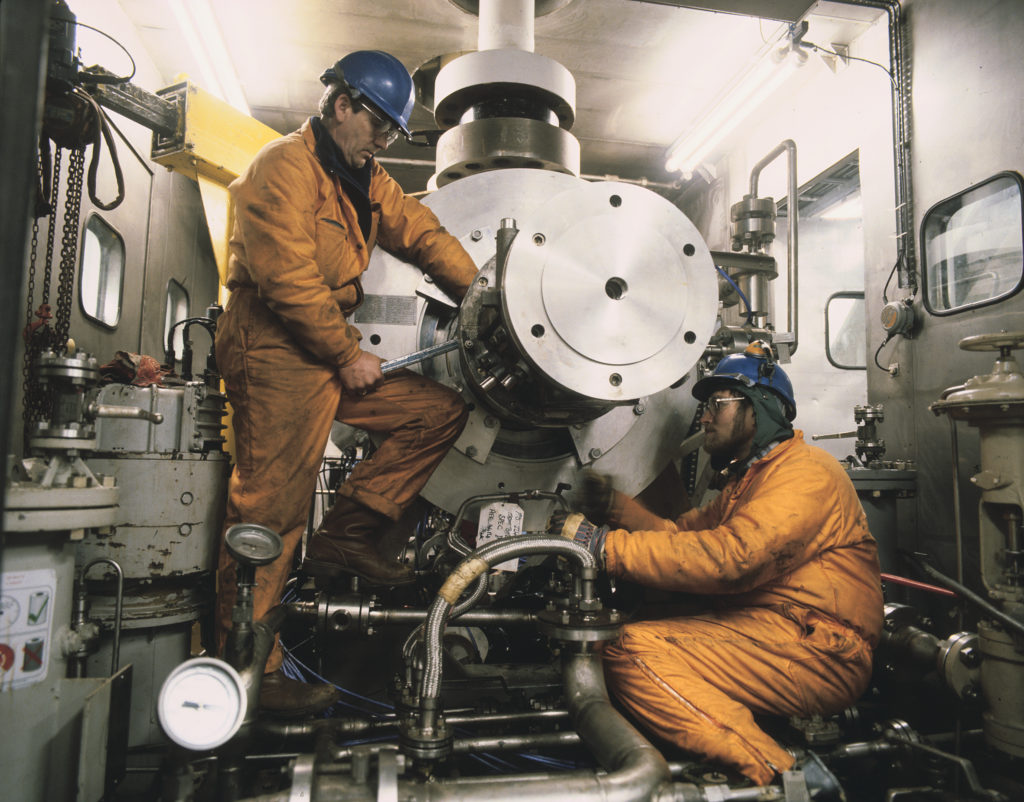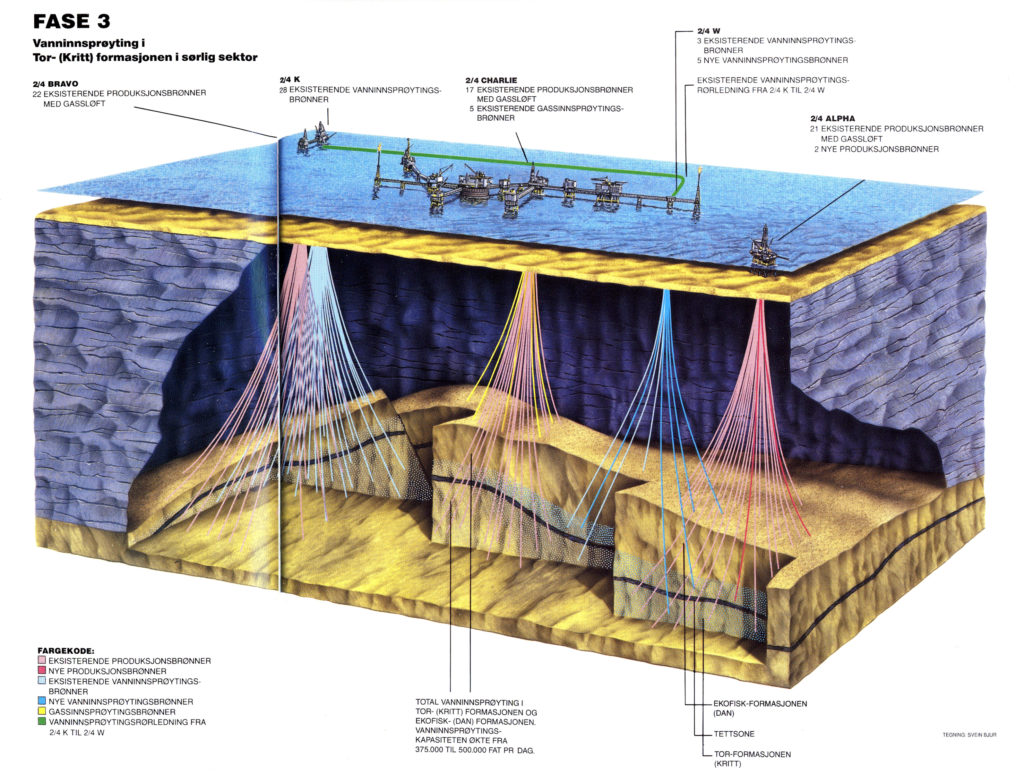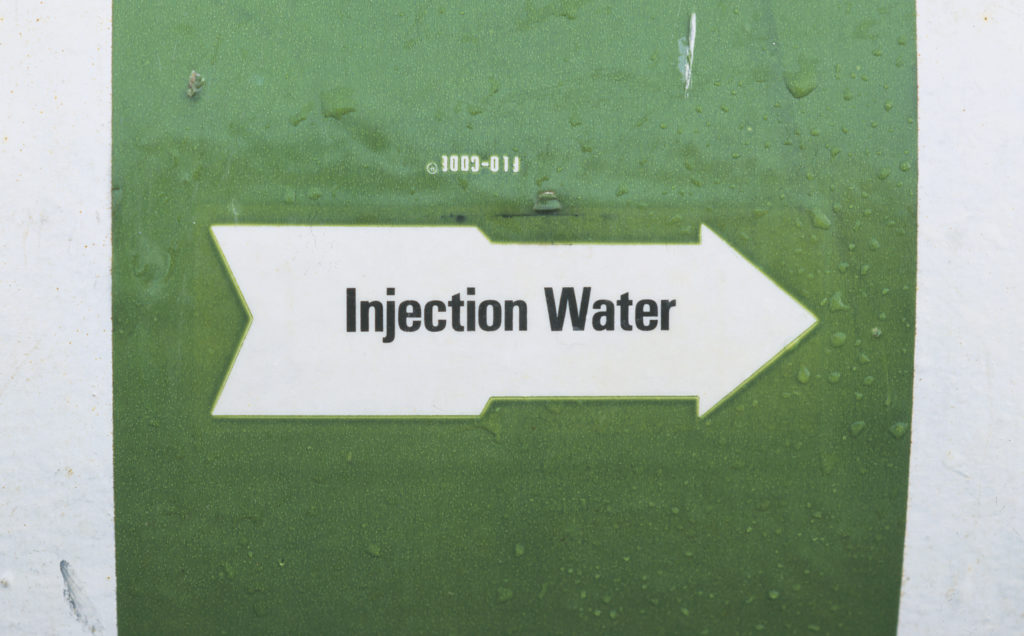Waterflooding

Estimates for reserves in a field are presented as one figure for the initial “stock tank oil originally in place” (Stooip), and another for the share of that thought to be recoverable. Generally speaking, the Stooip is a relatively static figure, while the amount of recoverable oil can change over a field’s lifetime. Developing and adopting new technology can increase the recovery factor – the proportion of the oil which can be got out. [REMOVE]Fotnote: https://www.npd.no/en/facts/publications/reports/resource-report/resource-report-2017/technical-potential/
 Vanninsprøyting for økt utvinning,
Vanninsprøyting for økt utvinning,The average oil recovery factor for fields on the Norwegian continental shelf (NCS) is just under 50 per cent, with a goal of increasing this. Reservoirs with particularly good production properties may have an oil recovery factor of 70 per cent, while the figure for gas is often even higher. By comparison, Ekofisk’s recovery factor has risen from an initial 17 per cent in 1972 to more than 50 per cent in 2019. With a Stooip of 1 134 million standard cubic metres (scm), each additional percentage point added to the field’s factor represents huge value.
As oil production progresses, reservoir pressure will fall. When waterflooding is adopted, huge quantities of water are pumped into the reservoir to slow this decline. The principle is that the water drives the oil in front of it and thereby helps to maintain the level of production, with the best effect achieved by injecting the water under the lighter oil. As well as maintaining reservoir pressure, the water helps to displace the oil. In a number of cases, waterflooding has yielded a significant increase in the recovery factor from the original estimate.
The effect of such injection depends on conditions in the reservoir, such as water quality, rock properties, temperature and pressure. It is not always easy to predict what effect injecting water will have in a reservoir, and surprises have frequently been encountered after this process has started.
 illustrasjon,
illustrasjon,At some point, production costs will become too high and the field has to be shut down. The timing of this depends on the relationship between oil prices and operating expenses, and cessation plans have frequently had to be rescheduled.
All reservoir rocks are porous – in other words, they contain small pores which can fill with oil, gas or water. The chalk which makes up the Ekofisk reservoir is an example. It can therefore hold large quantities of oil and gas, but its permeability – the ability of these substances to flow through the rock – is low.
Chalk reservoirs and waterflooding
Chalk, a carbonate rock, is characterised by its softness – just like blackboard chalk. Generally speaking, it has poor production properties and thereby a relatively low recovery factor. [REMOVE]Fotnote: Facts 2005, The Norwegian Petroleum Sector, p 42. Chalk can be very porous and hold a great deal of oil and gas, but its permeability is often low. It therefore takes a long time to recover oil and gas from such reservoirs. [REMOVE]Fotnote: https://www.npd.no/en/facts/news/general-news/2011/40th-anniversary-for-Ekofisk/
The Joint Chalk Research (JRC) project was established in 1980 by the Norwegian Petroleum Directorate (NPD) and the Danish Energy Agency together with the licensees for chalk fields in the North Sea. Attention was to be concentrated on issues and challenges related to such reservoirs with the goal of improving recovery. [REMOVE]Fotnote: Kristin Henanger Haugen, “Long live chalk”, Norwegian Continental Shelf, no 1, 2004: 23.
In addition to waterflooding, compaction of the soft chalk rocks – when they become compressed after large volumes of oil and gas have been removed – increases reservoir pressure and thereby helps to drain the field. Eventually, however, relying on pressure support alone will become increasingly difficult. Studies have shown that high reservoir temperatures create good conditions for seawater injection.
Carbonate rocks are easily soluble, unlike such igneous types as gneiss and granite. Wherever carbonate deposits are found, they dissolve readily. The CO2 in the water makes it acidic, and helps to release the minerals in the rocks. [REMOVE]Fotnote: https://titan.uio.no/node/2324. Injecting water in such reservoirs will cause a degree of dissolution, which can in turn contribute to seabed subsidence.
 Startskudd for vanninnsprøyting på 2/4 W-modulen, forsidebilde, Vanninsprøyting for økt utvinning
Startskudd for vanninnsprøyting på 2/4 W-modulen, forsidebilde, Vanninsprøyting for økt utvinning